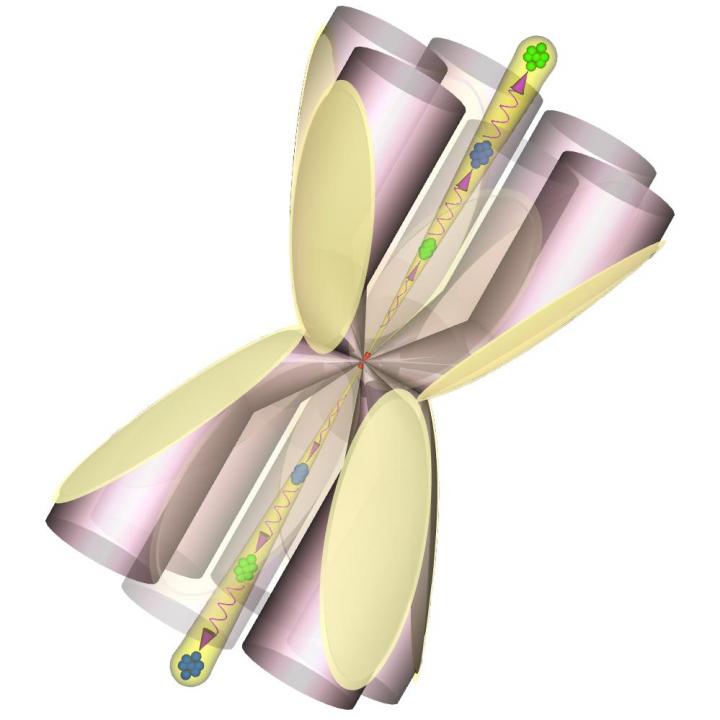
This is a field structure in a dipole wave. (Credit: E. Efimenko)
To achieve breakthrough research results in various fields of modern science, it is vital to develop successful interdisciplinary collaborations. Long-term interaction of physicists from the Institute of Applied Physics of the Russian Academy of Sciences, researchers from Chalmers University of Technology and computer scientists from Lobachevsky University has resulted in a new software tool PICADOR developed for numerical modeling of laser plasmas on modern supercomputers.
The work on the PICADOR software system started in 2010. PICADOR is a parallel implementation of the particle-in-cell method that has been optimized for modern heterogeneous cluster systems. The project combined the competencies and efforts of experts from different fields, thus becoming the basis for the well-thought-out optimization and development of new computing approaches that take into account various physical processes. Eventually, this opened the way for a breakthrough in modeling capabilities in a number of research projects. The system’s outstanding functional capabilities and performance make it possible to perform numerical simulations in a range of problems at the forefront of modern laser plasma physics.

Left image — density distribution at the beginning of the interaction, central image — several thin sheets are formed, right image — the final stage of evolution, two sheets are formed. (Credit: E. Efimenko)
In their article published in Scientific Reports, Nizhny Novgorod scientists have formulated the conditions (that were found theoretically and verified in a numerical experiment), under which the avalanche-like generation of electrons and positrons in the focus of a high-power laser pulse yields the electron-positron plasma of record density. The study of such objects will make it possible to approach the understanding of processes occurring in astrophysical objects and to study elementary particle production processes.
A well-known fact in quantum physics is the possibility of transformation of certain particles into other particles. In particular, in a sufficiently strong electric or magnetic field, a gamma photon can decay into two particles, an electron and a positron. Until now, this effect was observed in laboratory conditions mainly when gamma radiation was transmitted through crystals in which sufficiently strong fields exist near atomic nuclei. However, in the nearest future scientists can get a new tool for studying this phenomenon: lasers capable of generating short pulses with a power of more than 10 petawatt (1 petawatt = 1015 watt = 1 quadrillion watt). This level of power is achieved by extreme focusing of radiation. For example, scientists suggest using a laser field configuration, which is referred to as dipole focusing. In this case, the focus point is irradiated from all sides, as it were. Previously, it was shown theoretically that electron-positron avalanches can be observed at the focus of such a laser facility: particles created by the decay of a gamma photon will be accelerated by a laser field and will emit gamma photons, which in turn will give rise to new electrons and positrons. As a result, the number of particles in a short time should grow immensely giving rise to a superdense electron-positron plasma.

Electron and positron beams as well as gamma photons are emitted from the focus along the symmetry axis. (Credit: E. Efimenko)
However, there are some limitations on the density of the plasma that can be obtained in this way. At some point, the laser radiation will not be able to penetrate the plasma that has become too dense, and the avalanche will cease to increase. According to existing estimates, particle concentration in the laser focus will be just over 1024 particles per cubic centimeter. For comparison, approximately the same electron concentration is found in heavy metals, for example, in platinum or gold.
In their new paper, a team of authors headed by Professor A.M. Sergeev, Academician of the Russian Academy of Sciences, showed that under certain conditions this number can be an order of magnitude higher.
Large-scale numerical simulation of the electron-positron avalanche development in a tightly focused laser field demonstrated a fundamentally new object of investigation, the quasistationary states of a dense electron-positron plasma. These states have a very interesting and unexpected structure. While the laser field in the form of a dipole wave has an axial symmetry, the distribution of electron-positron plasma resulting from the development of the current instability degenerates into two thin layers oriented at a random angle. The thickness of the layers and particle concentration in these layers is apparently limited only by the randomness of the radiation process, which leads to extreme plasma density values. With a total number of particles of the order of 1011, the density exceeds the value of 1026 particles per cubic centimeter, and in our case it was only limited by the resolution of numerical simulation.




